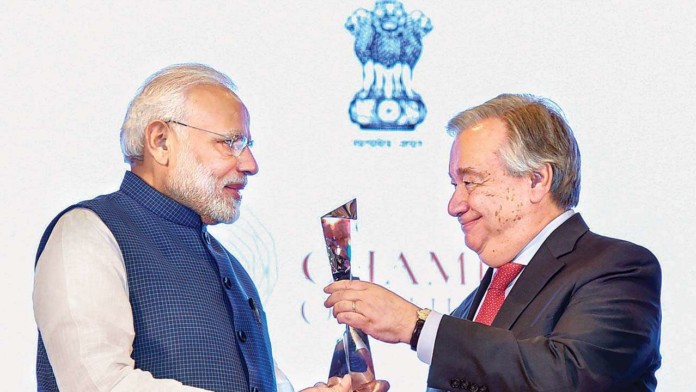Awards usually come with double edge – they make people, teams and nations proud at the same time raise very high expectations.
The 2018 Champions of The Earth Award to Prime Minister Narendra Modi made India proud but also made most Indians feel as if it was a joke. Social media was agog with ridicule of how a country that ranks 177 in the Environmental Performance Index can become eligible for such an award.
A January 2018 announcement showed India was among the bottom five countries on the Environmental Performance Index, plummeting 36 points from 141 in 2016, according to a biennial report by Yale and Columbia Universities along with the World Economic Forum.
The UN award recognized leaps India had achieved in renewable energy, delivering 300 million LED bulbs at affordable costs replacing nearly all incandescent and tube lights in the last four years. It’s a different matter that the discarded bulbs have severely contaminated India’s soil of highly harmful mercury that’s present in CFL bulbs.
The clean India drive has raised cleanliness consciousness significantly in a country that only treats one fourth of its solid waste. The municipalities and corporations have their hands tied due to insufficient resources and mafia dictating how much garbage is to be picked up each day. Except for cities like Indore or Surat, there’s no noticeable improvement among others.
13 out of 20 world’s most polluted cities are in India. There’s hardly any news about efforts to combat it although affordable technologies are available indigenously.
Environmentalists don’t give enough credit to the government for keeping fuel prices high despite temptation to reduce in the last four years when oil prices were ridiculously low. It’s proven that high prices are the best way to control consumption. Bringing diesel prices closer to petrol is also a significant achievement since diesel causes most of the pollution.
India’s power demand will double over the next decade. Its draft National Electricity Plan (NEP) calls for rising demand to be met with 275 gigawatts (GW) total renewable energy capacity by 2027, without requiring new coal plants beyond those already under construction.
However, the biggest headache for the government today is how to firstly shut down very old coal plants, how to retrofit some of them and make them flexible and yet viable. Despite significant progress in renewable energy generation, India will continue to depend on coal power for more than 50% for a long time. The challenge is how to improve the quality of coal power – which requires huge investments.
India played a leadership role in the Paris climate summit in 2015 and agreed for very bold measures. Modi’s pledge to eliminate all single-use plastic in India by 2022 and take on its comprehensive afforestion initiative with $6 billion investment, are highly assuring.
It’s a very Indian trait that we are able to shine when it comes to taking on new challenges but make snail-paced progress on solving legacy problems like cleaning rivers. New projects come with big money, solving old problems requires dealing with dirty politics. No prize for guessing which one is attractive for political parties.
India has a long way to catch up. Awards do help in speeding up the game.










